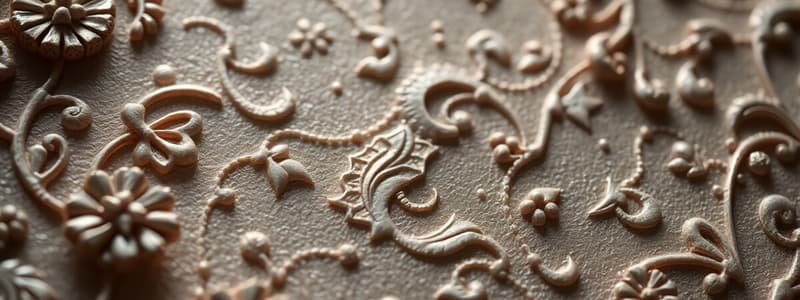Podcast
Questions and Answers
What effect does an increase in cutting speed have on surface roughness?
What effect does an increase in cutting speed have on surface roughness?
- It has no effect on surface roughness.
- It decreases surface roughness. (correct)
- It increases surface roughness.
- It causes irregular surface patterns.
Which of the following materials is categorized as isotropic?
Which of the following materials is categorized as isotropic?
- Pure metals like lead.
- Composite materials.
- Ceramics like glass and zirconia. (correct)
- Wood-based materials.
What property is measured by the integral of deviation from the mean value known as Ra?
What property is measured by the integral of deviation from the mean value known as Ra?
- Surface roughness. (correct)
- Material strength.
- Surface lay.
- Surface hardness.
How does the use of cutting fluids during machining processes affect surface roughness?
How does the use of cutting fluids during machining processes affect surface roughness?
Which of the following statements about the effect of increasing feed on average roughness is true?
Which of the following statements about the effect of increasing feed on average roughness is true?
What is the primary material recommended for the fishing reel to withstand salt-water use?
What is the primary material recommended for the fishing reel to withstand salt-water use?
Which manufacturing method is deemed most cost-effective for producing an aluminum fishing reel?
Which manufacturing method is deemed most cost-effective for producing an aluminum fishing reel?
In the redesign of the truck sheet metal fan cover, what was the impact on material costs?
In the redesign of the truck sheet metal fan cover, what was the impact on material costs?
What is one benefit of designing different parts to have the same initial geometry for milling operations?
What is one benefit of designing different parts to have the same initial geometry for milling operations?
Which part of the robot arm gripper is made using casting with nylon material?
Which part of the robot arm gripper is made using casting with nylon material?
What design change resulted in a 17% reduction in machining time for a sophisticated bracket?
What design change resulted in a 17% reduction in machining time for a sophisticated bracket?
Which of the following best describes the term 'design for manufacturing'?
Which of the following best describes the term 'design for manufacturing'?
What is a key drawback of using 5-axis CNC milling for bracket production?
What is a key drawback of using 5-axis CNC milling for bracket production?
Which parameters are required to describe linear elastic material behavior?
Which parameters are required to describe linear elastic material behavior?
What stress condition is analyzed under a Brazilian test?
What stress condition is analyzed under a Brazilian test?
What effect does cyclic loading have on materials, compared to static loading?
What effect does cyclic loading have on materials, compared to static loading?
What does the factor of safety represent in engineering design?
What does the factor of safety represent in engineering design?
Under the Von Mises criteria, which type of materials is the equivalent stress primarily applied to?
Under the Von Mises criteria, which type of materials is the equivalent stress primarily applied to?
Which material is considered isotropic?
Which material is considered isotropic?
Which test measures shear strength in a material?
Which test measures shear strength in a material?
What happens to the fatigue strength of a material when heat treatment is applied?
What happens to the fatigue strength of a material when heat treatment is applied?
In linear elastic material testing, which materials can be characterized from brittle to ductile?
In linear elastic material testing, which materials can be characterized from brittle to ductile?
What is the role of Finite Element Method (FEM) in product design?
What is the role of Finite Element Method (FEM) in product design?
Study Notes
Surface Characteristics
- Surface roughness is impacted by cutting speed, depth of cut, and feed rate
- Increased cutting speed results in less surface roughness
- Increased depth of cut leads to an increase in maximum roughness depth
- Higher feed rate corresponds to greater average roughness
- Cutting fluids reduce surface roughness by decreasing tool temperature and reducing friction
Material Behavior
- Isotropic materials have consistent properties in all directions
- Examples: Aluminum, steel, magnesium, copper, glass, zirconia, concrete, clay, basalt, epoxy, rubber, polycarbonate
- Anisotropic materials have varying properties depending on direction
- Examples: Copper at microscopic scale, fiber-reinforced composites, natural wood
Isotropic Material Behavior (Linear Elastic)
- Requires two material parameters to describe: Young's modulus ( E ) and Poisson's ratio (ν)
- Young's modulus and shear modulus (μ) are also used
- Linear elastic materials are suitable for Finite Element Method (FEM) simulations to determine equivalent stress
Stress-Strain Relation
- Brittle materials exhibit a linear elastic behavior followed by fracture
- Examples: Glass, concrete, and cast iron
- Ductile materials exhibit linear elastic behavior followed by yielding and then failure
- Examples: Some metals
Measurement of Limit Stress
- Uniaxial tensile tests measure the ultimate tensile strength and yield strength of materials for casting and machining
- Three point flexural tests are used for composite materials
- Brazilian tests are used for measuring the tensile strength of cylindrical materials like concrete and rocks
- Torsion tests are used for measuring the shear strength of materials
- Box tests are used for granular materials and rocks
- Iosipescu tests are used for measuring the shear strength of thin materials
Fatigue Strength
- Cyclic loading can cause fatigue damage, leading to fracture in brittle materials and rupture in ductile materials
- Fatigue strength is the stress level at which a material can withstand a specified number of cycles before failure
- Heat treatment can significantly impact fatigue strength
Equivalent Stress
- Equivalent stress is a single value that represents the combined effect of multiple stress components
- Von Mises criterion is used for ductile materials
- Tresca criterion is used for brittle materials
Factor of Safety
- Factor of safety is the ratio of the material's strength to the equivalent stress
- It provides a margin of safety to account for uncertainties and variations in material properties and loading conditions
- The required factor of safety depends on the application, material reliability, and environmental conditions
Design for Manufacturing
- Design for manufacturing considers manufacturability during the design process
- It focuses on minimizing costs, maximizing production efficiency, and ensuring product quality
- Key considerations include material selection, manufacturing methods, assembly, and cost analysis
Design for Manufacturing Examples
-
Fishing Reel:
- Initial design: plastic injection molding for affordability, but market research showed preference for metal
- Revised design: aluminum or stainless steel for saltwater use, die casting or stamping for cost-effectiveness
- Final design: aluminum stamping for the lowest cost
-
Robot Arm Gripper:
- Components: aluminum body, nylon gears, aluminum linkage, base plate, off-the-shelf pins and fasteners
- Manufacturing methods: milling, casting, stamping
-
Truck Sheet Metal Fan Cover:
- Redesigned to reduce costs by using the same material and sheet bending process
- Achieved 25% cost reduction despite a small increase in labor costs
-
Bracket Design:
- Redesigned for 3-axis milling instead of 5-axis CNC machining
- Sand casting considered as an even more affordable option
- Achieved a cost saving of approximately 2000 kr per 300 parts annually
-
Sophisticated Bracket:
- Redesigned for larger radius to allow the use of larger tools, reducing machining time by 17%
Material Supply Reduction
- Design parts with the same initial geometry for consistent milling operations and material procurement, reducing variations in material supply and costs
Tool Reduction in Milling
- Design parts for compatibility with the same tools in machining, minimizing tool changes and reducing variation in used tools, which lowers costs
Design for Manufacturing Conclusion
- Design for manufacturing involves a systematic approach to product design that considers manufacturability and cost-effectiveness
- It is an ongoing process with no single solution, requiring a conscious effort to balance functionality, cost, and producibility.
Studying That Suits You
Use AI to generate personalized quizzes and flashcards to suit your learning preferences.
Related Documents
Description
Explore the principles of surface characteristics and material behavior in manufacturing processes. Understand how cutting speed, depth of cut, and feed rate affect surface roughness, and discover the differences between isotropic and anisotropic materials. This quiz covers essential concepts related to linear elastic materials and their properties.




